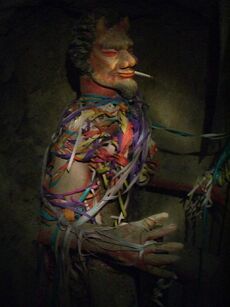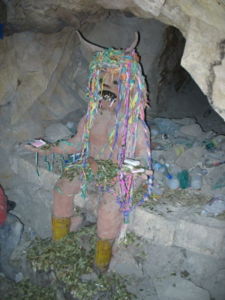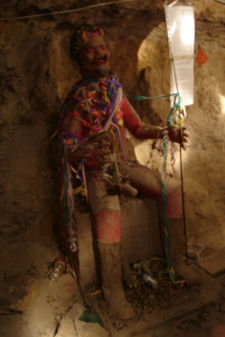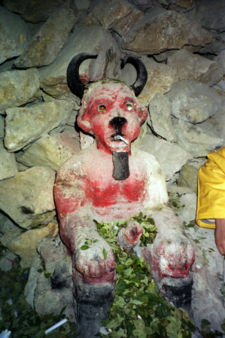El Tío: Difference between revisions
imported>Joe Quick ('nother pic - probably need to make a gallery for this one...) |
imported>Joe Quick |
||
| Line 18: | Line 18: | ||
<blockquote>The town would have disappeared because of internal fights had not Ñusta appeared on a rainbow one day after a heavy storm. Accompanying her were the chiefs and priests who had been exiled from the town when the people were perverted from their old ways. Little by little, men returned to what had been. They revived their traditions, customs, religion, and social order. They imposed Quechua on the Uru dialect. The fields would have recovered and even surpassed their fertility if Huari, in vengeance, had not sent four plagues on the repentant town: a serpent, a toad, a lizard, and ants. The monstrous serpent moved from the mountains of the south and devoured their fields and flocks. The Urus saw him and fled in terror, when suddenly someone shouted for Ñusta, and the monster was divided in two by a sword. The other three plagues, advancing from the other compass points, were also killed by the intervention of Ñusta, who overwhelmed the vengeful Huari. Today a chapel stands on the hill where the giant lizard was killed. It is said that the lake [near Cala Cala] still turns red at dawn from the blood of the lizard that flowed into it. The ants were turned into sand dunes that can still be seen on the southern borders of the town. Peace returned to the town.</blockquote> | <blockquote>The town would have disappeared because of internal fights had not Ñusta appeared on a rainbow one day after a heavy storm. Accompanying her were the chiefs and priests who had been exiled from the town when the people were perverted from their old ways. Little by little, men returned to what had been. They revived their traditions, customs, religion, and social order. They imposed Quechua on the Uru dialect. The fields would have recovered and even surpassed their fertility if Huari, in vengeance, had not sent four plagues on the repentant town: a serpent, a toad, a lizard, and ants. The monstrous serpent moved from the mountains of the south and devoured their fields and flocks. The Urus saw him and fled in terror, when suddenly someone shouted for Ñusta, and the monster was divided in two by a sword. The other three plagues, advancing from the other compass points, were also killed by the intervention of Ñusta, who overwhelmed the vengeful Huari. Today a chapel stands on the hill where the giant lizard was killed. It is said that the lake [near Cala Cala] still turns red at dawn from the blood of the lizard that flowed into it. The ants were turned into sand dunes that can still be seen on the southern borders of the town. Peace returned to the town.</blockquote> | ||
Though images of Supay were present in the mines prior to the arrival of the Spanish, mining activities under Inca rule were practiced on a small scale and did little to change the ritual relationships between the miners and the spirits – it was not until the intensification of mining under colonial rule that Huari’s evil temperament, so palpable in the myth quoted above, began to appear.<ref name="Taussig 1980" /> Catholic priests regarded much of the indigenous religion as idolatry and worked to rearticulate indigenous beliefs, re-envisioning native spirits as figures from the Christian pantheon – within indigenous mining communities, Ñusta became the Virgin of the Mineshaft and the spirit of the hills became the Devil. The transformation continued as Huari began to take on many of the characteristics of the mine owners and administrators who compelled the indigenous population to enter the mines under grueling and often fatal conditions. | Though images of Supay were present in the mines prior to the arrival of the Spanish, mining activities under Inca rule were practiced on a small scale and did little to change the ritual relationships between the miners and the spirits – it was not until the intensification of mining under colonial rule that Huari’s overtly evil temperament, so palpable in the myth quoted above, began to appear.<ref name="Taussig 1980" /> Catholic priests regarded much of the indigenous religion as idolatry and worked to rearticulate indigenous beliefs, re-envisioning native spirits as figures from the Christian pantheon – within indigenous mining communities, Ñusta became the Virgin of the Mineshaft and the spirit of the hills became the Devil. The transformation continued as Huari began to take on many of the characteristics of the mine owners and administrators who compelled the indigenous population to enter the mines under grueling and often fatal conditions. | ||
Prior to the nationalization of the mines in 1952, miners were organized into work groups and paid according to the amount and quality of the ore that they were able to extract from the mine. These workgroups would perform the rites to the Tío as a way to reinforce group solidarity and to gain an edge over rival workgroups by winning the Tío’s favor. Those who went into the mines alone were suspected of making deals with the Tío for their personal gain – it is said that those who sell their souls to the Tío for riches die within 30 days. | |||
Following the nationalization of the mines and the military coup of 1965, the miners’ relationship with the spirit of the hills changed again. Workers were paid standard wages rather than by their production rates so supplications to the Tío for increased productivity were no longer necessary. Such rites were also suppressed by the mining administrators, as were indigenous rituals throughout the country. Despite these pressures, the ch’alla and the k’araku continued to be practiced clandestinely as a source of solidarity and cultural pride. Today, many miners continue to make small daily ritual sacrifices to the Tío in return for his protection in the mine while larger ceremonies are held following tragedies in the mines and on the appropriate days in the ritual calendar. | |||
==The Tío’s Dominion== | ==The Tío’s Dominion== | ||
Revision as of 23:24, 8 July 2007
In the mines of highland Bolivia, "El Tío" (Spanish for "Uncle") is the familiar name for the spirit owner of the mountain, who is also known as Huari or Supay. He is associated with pre-Hispanic nature spirits as well as the Christian Devil and is a central figure in the ritual life of Bolivian mining communities. An image of the Tío is situated in each mineshaft to receive sacrificial offerings of alcohol, coca, cigarettes, llama blood and other ritual items from the miners in return for his good will and his guarantee of good health and good fortune in the mines.
The Images
The Tío may take several different forms, including the specter of a bearded blond man resembling mine administrators or a succubus,[1] but he most often appears inside the mines in his physical form as a clay figure resembling popular notions of the Christian Devil. Typically, an image of the Tío is to be found seated in each active mineshaft in a niche near the miners’ work area.
The figures vary widely in their size and composition. Some, like the image from the Cerro Rico mine now on display in the museum there, are elaborately sculpted and decorated and may be as large as a human. Most images are smaller and less gaudy, but still easily identifiable due to the conspicuous horns that grow from the Tío’s head. His eyes may be made of discarded light bulbs from the miners’ helmets or pieces of metal ore and his teeth are often formed of shards of glass or crystal. Images of the Tío embody his greed and insatiability – his mouth is open to accept cigarettes and coca, his hand is outstretched for offerings of alcohol, his erect phallus betrays his voracity. Surrounding the images are streamers or bits of confetti from past rites and the remnants of the offerings that the miners have made to satiate the Tío’s voracious appetite.
The Ch’alla and the K’araku
Two types of offering are made to the Tío: the ch’alla and the k’araku.
History
Spirits similar to the Tío were present in the Bolivian highlands long before Spanish explorers arrived to lay claim to the hills and the riches they contain. In the pre-Columbian culture of the Andean plateau, nature spirits held power over the life and death of the Aymara people as well as the resources that were contained in the land that they inhabited. Health and good fortune were guaranteed for the community by entering into ritual relationships of sacrifice and exchange with the spirits – caring for the spirits ensured that the spirits would care for them. These spirits took on physical form as prominent boulders and rock faces in the surrounding landscape.
In agricultural communities, devotions to the nature spirits remain an important part of ritual life, but the spirit of the hills has risen to a conspicuous position in the devotional lives of the mining communities of the region. Like the other spirits, Supay was originally a highly ambivalent entity, capable of bringing good fortune as well as bad fortune. Sacrificial offerings to him ensured his good disposition and helped to maintain equilibrium in the forces that governed his domain. With the increased disturbance of those forces caused by mining activities, the spirit of the hills began to change in nature, becoming more malevolent in character and more vengeful in his actions. One myth, translated by June Nash from Beltrán Herédia, sets the stage for this transition:[2]
The community of Uru Uru [pre-Hispanic name for Oruro] was one of fishermen and pastoralists devoted to the worship of the Sun. Every day Huari [the spirit of the hills] was awakened by the first-born daughter of the Sun, Ñusta. He fell in love with her and pursued her with arms of smoke and volcanic fire. The father came to her aid and hid her in the caves. Huari swore that he would bring vengeance against the town by turning it against the true religion. He became the apostle of a new religion and preached against Pachamac and his religious and social work. He thundered against Inti, the Sun God, and the old social hierarchy. He exalted in the superiority of material goods over spiritual, and of the labor of the mines over that of the field. The Urus resisted, but when Huari showed them gold and silver, they rebelled against their old beliefs and sacred authorities. Desirous of riches, they abandoned the daily hard but healthy work in their fields. They stopped praying to Inti and turned to wild drinking and midnight revels with chichi, a liquor unknown before then. In their drunken state there came forth serpents, toads, lizards, and ants who, in the acts of the witches’ Sabbath, overwhelmed them. The inhabitants of the neighboring towns and even their friends and parents appropriated their goods. The people, abject with vice, were transformed into apathetic, silent and loveless beings.
The town would have disappeared because of internal fights had not Ñusta appeared on a rainbow one day after a heavy storm. Accompanying her were the chiefs and priests who had been exiled from the town when the people were perverted from their old ways. Little by little, men returned to what had been. They revived their traditions, customs, religion, and social order. They imposed Quechua on the Uru dialect. The fields would have recovered and even surpassed their fertility if Huari, in vengeance, had not sent four plagues on the repentant town: a serpent, a toad, a lizard, and ants. The monstrous serpent moved from the mountains of the south and devoured their fields and flocks. The Urus saw him and fled in terror, when suddenly someone shouted for Ñusta, and the monster was divided in two by a sword. The other three plagues, advancing from the other compass points, were also killed by the intervention of Ñusta, who overwhelmed the vengeful Huari. Today a chapel stands on the hill where the giant lizard was killed. It is said that the lake [near Cala Cala] still turns red at dawn from the blood of the lizard that flowed into it. The ants were turned into sand dunes that can still be seen on the southern borders of the town. Peace returned to the town.
Though images of Supay were present in the mines prior to the arrival of the Spanish, mining activities under Inca rule were practiced on a small scale and did little to change the ritual relationships between the miners and the spirits – it was not until the intensification of mining under colonial rule that Huari’s overtly evil temperament, so palpable in the myth quoted above, began to appear.[1] Catholic priests regarded much of the indigenous religion as idolatry and worked to rearticulate indigenous beliefs, re-envisioning native spirits as figures from the Christian pantheon – within indigenous mining communities, Ñusta became the Virgin of the Mineshaft and the spirit of the hills became the Devil. The transformation continued as Huari began to take on many of the characteristics of the mine owners and administrators who compelled the indigenous population to enter the mines under grueling and often fatal conditions.
Prior to the nationalization of the mines in 1952, miners were organized into work groups and paid according to the amount and quality of the ore that they were able to extract from the mine. These workgroups would perform the rites to the Tío as a way to reinforce group solidarity and to gain an edge over rival workgroups by winning the Tío’s favor. Those who went into the mines alone were suspected of making deals with the Tío for their personal gain – it is said that those who sell their souls to the Tío for riches die within 30 days.
Following the nationalization of the mines and the military coup of 1965, the miners’ relationship with the spirit of the hills changed again. Workers were paid standard wages rather than by their production rates so supplications to the Tío for increased productivity were no longer necessary. Such rites were also suppressed by the mining administrators, as were indigenous rituals throughout the country. Despite these pressures, the ch’alla and the k’araku continued to be practiced clandestinely as a source of solidarity and cultural pride. Today, many miners continue to make small daily ritual sacrifices to the Tío in return for his protection in the mine while larger ceremonies are held following tragedies in the mines and on the appropriate days in the ritual calendar.
The Tío’s Dominion
The Diablada
The Tío leaves the mine only for the Diablada, a dance performed during Carnival in honor of the Virgin. The exact origins of this dance are unknown but it is thought to have been first performed in Oruro.[3] The dance tells three stories, including the legend of Huari quoted above, the appearance of the Virgin of the Mineshaft to the thief Chiruchiru, and the Archangel Michael’s triumph over the seven deadly sins. Devil characters wear ornate costumes adorned with frog, lizard and snake figures in the belief that "if they wear devil costumes during Carnival, [the Tío] will identify and sympathize with them, and will bring them wealth and good luck in the coming year."[3] The devils are joined in their dramatic performance by other dancers masquerading as China Supay (the devil’s consort), angels, bears, and female devils.
External Links
- The Devil’s Miner – Website for an award winning documentary about two young brothers who work in the Cerro Rico mine in Potosi. Site includes background information about the Tío and stunning photos of life in the mines.
Sources
- ↑ 1.0 1.1 Michael T. Taussig. 1980. The Devil and Commodity fetishism in South America. ISBN 0-8078-4106-4
- ↑ June Nash. 1993. We Eat the Mines and the Mines Eat Us: Dependency and Exploitation in Bolivian Tin Mines. ISBN 0-231-08051-4
- ↑ 3.0 3.1 Cynthia Lecount. 1999. Carnival in Bolivia: Devils dancing for the virgin. Western Folklore 58(3/4):231-252.



